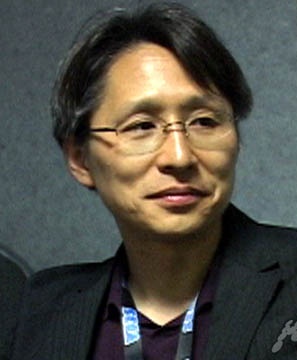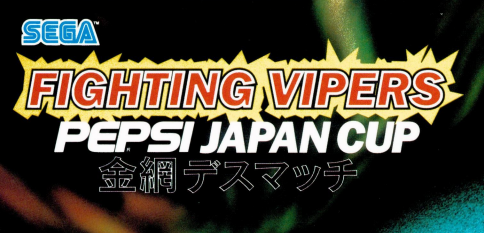Published in 1996. Articles from the physical book component of the Fighting Vipers Digital Collection. This part covers the conception of the game with director Hiroshi Kataoka, and details regarding the Pepsi partnership with publicity manager Fumio Kurokawa.
Thanks to @Zerochan for providing images of the original articles.

Bursting out with unprecedented style
On the surface, Sega Enterprises AM Research & Development No. 2 seems like no more than just one of several sections of the company focused on developing arcade games. But, you probably won’t find a single gamer in Japan who doesn’t know about AM2’s 1993 release, “Virtua Fighter”. And with its founder, Yu Suzuki, who brought epoch-making games like Hang-On, Out Run, and After Burner into the world one after another, the weight of AM2’s name is certain. But wait, the team who made Virtua Fighter made another fighting game that’s not Virtua Fighter? Having the same team within the same company make another 3D fighting game was truly a bold plan. Why would they do this? What was their goal? Once again, the idea behind the Fighting Vipers was proposed by AM2’s head, Yu Suzuki, who would also serve as the game’s producer. The idea that came directly from Mr. Suzuki’s mouth during the planning stages was “let’s make a fighting game where armored characters will fight in an enclosed ring”. A key figure in the development of Fighting Vipers, its project leader Mr. Kataoka, speaks:
Kataoka: We got the word from the division head, and started on that plan. Of course, it’s hard to ignore the existence of Virtua Fighter. But we didn’t want to make it something that was too similar, nor did we focus too much on making it entirely different. We had settled on using the same 3 button system as Virtua Fighter in the early stages of development. Lots of people had already gotten the hang of that system, so it would be easy for them to make the jump. And we thought it was a great system in the first place. So on that level it ends up looking identical to Virtua Fighter, meaning we aimed to make the actual contents of the game and its fights completely different.
And so, with the final product, Fighting Vipers, they were perfectly able to draw a line between it and the Virtua Fighter series. The familiar stick and three button setup, and even some inputs, run directly from Virtua Fighter through to Fighting Vipers. But it was clear that there was a different feeling about the game.
Is that feeling the trading of an elevated ring for a claustrophobic wire netting? Is that feeling the striking character designs? Or is that feeling the eye-catching palette?
No, it’s not that. If you try playing it, it’ll hit you right away: The difference between Virtua Fighter and Fighting Vipers is the feeling of exhilaration!
In the fences, and in the armor, and in the “bang”s and “boom”s. There’s no other fighting game that puts the joy of breaking things front-and-center like Fighting Vipers. Where do you find that feeling? In the fences? The characters? The armor? Nope, in everything. The thrill of fighting on the glass-enclosed Raxel stage, and watching your opponent’s outlandish character fall to the ground surrounded by shards of glass. That’s the feeling! Or if you’re on the other side, the equivalent total mortification of losing.
Kataoka: At first, the armor would come off one piece at a time. If you just hit the shoulder, the shoulder would come off, or if you just hit the stomach, the stomach would come off, but you couldn’t follow it at all when it was so little by little. It ended up turning into a weird game. Then I received advice from the department head: to make the armor breaking properly visible, split it into upper body and lower body. After you KO your opponent, if you hit them with a down attack, these white things fly around, like fireworks. I don’t really know what they’re supposed to be, but it feels good. Throughout the whole game, be it smashing through glass or breaking armor, we added a feeling of catharsis. If you can, I think it would be good to worry less about winning or losing, and just try to focus on enjoying that feeling. Like, smashing plates is no good, so instead please drop in a coin and smash some glass. (laughs)
So, to get some catharsis, read up on Fighting Vipers, and try giving it a shot!

Sega AM2 Publicity Section Manager
In charge of providing material to various media. Today, we asked him about the in-game advertising.
In-Game Advertising
In the past, games have included on-screen advertising, with corporate logos featured in game. Fighting Vipers doesn’t just stop there, and goes a step beyond that with in-game advertising. The man behind this is Fumio Kurokawa, who is in charge of the publicity section of Sega AM2.
We experimented with the idea in the past, in games like Daytona USA and Virtua Striker, but we wanted to do something more elaborate. In Fighting Vipers, we were able to make this a reality. This isn’t simply sticking logos in the game, it’s carefully intertwined with the characters. We were able to realize it better than we had ever imagined.
Right now, the line of commercials Pepsi is running is “Pepsiman”. The coolness of Pepsiman and his commercials reach mass media in a way that a human mascot can’t. We’re also big fans. We felt it would link nicely with the aesthetic of Fighting Vipers. The end result got a strong reaction from the general public and the media, and we got a great response from Pepsi themselves as well. The initial plan was just in-game advertising, but after such strong enthusiasm, in the end they provided a significant amount of money for a national tournament, and it became a sponsorship.
As far as in-game advertising goes, we don’t really have data to show regarding the effectiveness. But right now, we’re also working on the marketing for Virtua Fighter Kids, which includes advertisements for Otsuka Beverage.
There’s generally two directions for in-game advertising. The first is the subliminal kind, which you often see in driving games or stadium signboards. This is a pretty basic implementation. The other method involves intertwining it with the characters’ story and actions. I call the former “in-game advertising”, and the latter “Virtua Advertising”. Either way, I think both have a place. But in order to allow for higher exposure of the advertisements, I think it’s necessary to properly perform the latter. It’s easy to just plop down a signboard, but that won’t reach as far.
Arcade games are still limited by the Businesses Affecting Public Morals Regulation Act, though it’s just thought of as a custom at this point. Still, I think that with time, those kinds of customs become part of the culture. In order of games to be thought of as more than just games, we need to inject new blood in them. If we take games as they are, add Pepsi advertisements, hold tournaments, get an Otsuka Beverage sponsorship, the idea becomes much more commonplace. Movies have 100 years of developing a culture, and I think games can do the same. I think that games might even be able to reach the level of movies in less than 100 years. So, in order to aid that acceleration, my hope is that we have developments in this kind of “cross-pollination”, allowing the circle of games to expand, and receiving a different kind of appreciation. Maybe that’s a bit grandiose (laughs). I’d like to see lots of companies try something like “Virtua Advertising”, and have gaming as a medium develop nicely. We’re trying to have games go beyond mass consumption, and approach a greater part of culture and entertainment. From a corporate standpoint, “Virtua Advertising” has that kind of rebellious undertone to it. Or maybe I’m getting a bit self-important here (laughs).
-Kurokawa
